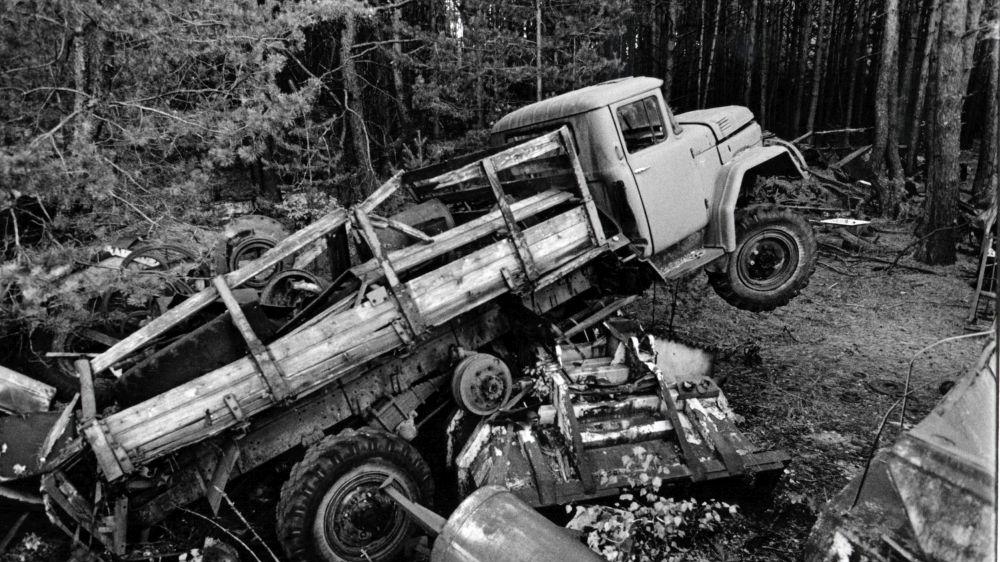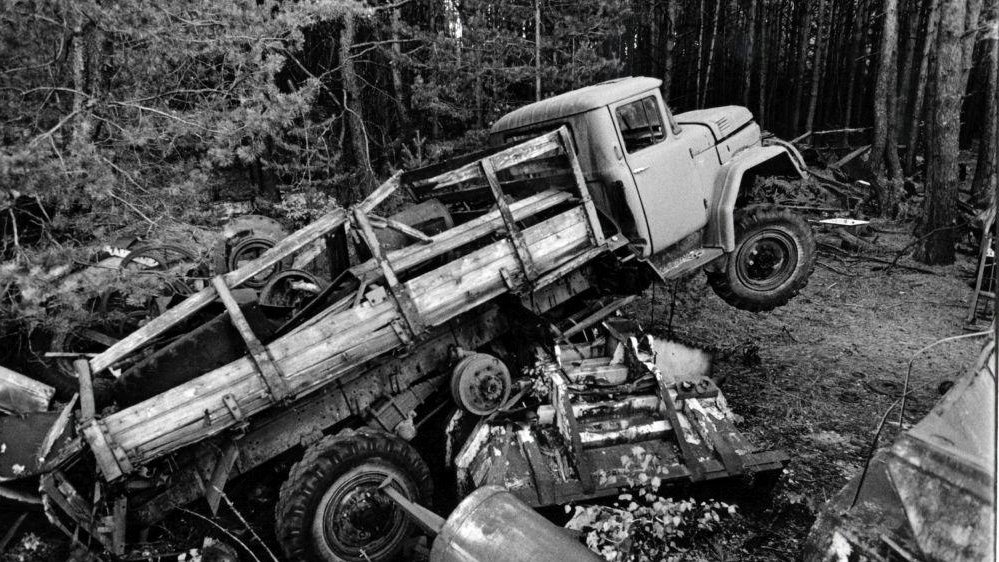Chernobyl draws adrenaline junkies no longer satisfied with garden-variety entertainment commonly served to people in our "safe" world. The place is a magnet for sensation hunters with interest in the conceited side of human nature, the side that makes you think you are fully in control. After all, Chernobyl is mainly a symbol, one brim-full of meanings and angles, that offers those who set out to explore it the hope there is always an untold story to be told and an imminent sensation to chase after that will satisfy our hunger. Surprisingly, the endless supply of occasional publications and supposedly astonishing media reports on Chernobyl never cease to capture our interest. The question is, is this interest enough to terrify us and prompt deeper reflection? Are there emotions associated with it?
I must admit that as I viewed the photographs from the Chernobyl collection by Jerzy Wierzbicki, which were on display at the Zamek Cultural Centre in March, these very questions were prominently on my mind. The photos were taken in October 2015 during the few days the photographer stayed in Chernobyl. They were shown on BBC News in 2016 on the 30th anniversary of the disaster. Do they reveal anything we don't already know? After all, images of this place are all the same: derelict deserted buildings, abandoned possessions. All of them crumbling, falling apart and demonstrating the passage of time. One can sense an overwhelming emptiness and get an eerie feeling that everything has been forsaken abruptly, without looking back, in a state of bewilderment. And although we seem to realise how tragic it must have been for the evacuees to leave their belongings behind and give up all hope of ever returning to this place that at the time claimed to be modern to live a normal life again. With emphasis on "seem to realise".
As I searched for answers to all these questions, I was forced to admit to myself that, well, what the photographs documented no longer moved me very much. Why? We have all seen countless depressing scenes. We are flooded daily by such a barrage of dismal images of human tragedy that the Chernobyl photos no longer impress us much. So what, we say, it's just another abandoned flat, more scratched walls, another old photograph that belongs to a person who is long gone, a view of once modern buildings and anti-American propaganda posters - none of that is new. We have seen all the images before and have grown desensitized to them. They make us feel even more distanced in time and space. We take interest in Chernobyl as we look at it from a safe distance. We take comfort in this being only a picture, and us being just viewers. It is easy to catch oneself thinking that Chernobyl is removed from this world, it may well even be in a whole different dimension. We no longer think about what might ensue if such a catastrophe happens again. We are confident that such a thing would be impossible.
And who is being impudent here? Is it the Soviets of that time or us today? Are we sure we have learned our lesson from history? Although 35 years will soon have passed since these events unfolded with grave consequences for the whole rest of the world, I get the impression that for many of us, it has been much longer. So much longer, in fact, that we are unable to relate to it with compassion, although - depending on our age - we ourselves, and certainly our parents and grandparents, have once lived in that chaotic world with all its disinformation. And although they did not directly suffer from the explosion of Reactor 4, everyone at the time was a victim one way or another. A wave of destruction swept far and wide. Today it hardly affects us anymore and we don't give it much thought. Instead, we consider Chernobyl a place worth seeing. Wierzbicki himself seems to have visited this site drawn by the natural curiosity of a tourist.
However, my being dispassionate in viewing the photos, and I can't think of another word to describe it, has reached its end. There is life in there somewhere, symbolised by the old, wrinkled but good-natured faces of Maria and Ivan Semieniuk, current residents of the village of Paryshiv, 17 km from the power plant, smack in the middle of the exclusion zone. And only this, more than anything else, allows one to remember that someone actually used to live there and that someone ended up displaced. There were people who called the Chernobyl area home and were forced to abandon it under duress. Some of them chose to return there in defiance of the law and in complete disregard for safety. This air of normalcy, this natural and familiar spirit emanating from the couple, shakes one out of one's torpor prompting very different, less biased questions about the past, present and future of Chernobyl. Questions about attachment to this place, about banishment and a simple person's entanglement in big history and dramatic events that resonate widely.
I am reminded of an excerpt from the book Chernobyl Prayer. A Chronicle of the Future by Svetlana Alexievich: "Fate is the life of an individual, history is the life of us all. I want to recount history without losing sight of the fates of individuals. For fate goes further than any idea." Haven't we lost sight of something?
Justyna Żarczyńska
translation: Krzysztof Kotkowski
- Exhibition: Chernobyl (Czarnobyl)
- CK Zamek (ZAMEK Culture Centre), Hol Wielki (Grand Lobby)
- open until 28.03. (10 am - 8 pm)
- online access: Chernobyl
© Wydawnictwo Miejskie Posnania 2021




